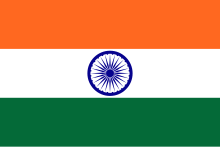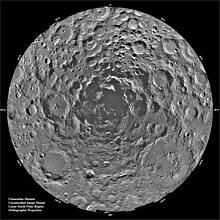India's flag lands on Moon
Saturday, November 15, 2008
At 8:34 pm Indian time Friday night (1504 UTC), India became the fourth country to land its flag on the Moon.
The unmanned lunar orbiter Chandrayaan-1 ejected its Moon Impact Probe (MIP), which hurtled across the surface of the Moon at 1.5 kilometres per second (3000 miles per hour), and successfully crash landed near the Moon's south pole. Besides carrying three important scientific instruments, the lunar probe also carried the image of the Indian national flag, painted on all sides.

Chandrayaan-1 (meaning 'Moon craft' in Sanskrit) reached its target lunar orbit on Wednesday. The orbiter will remain in a circular orbit 102 kilometres above the Moon's surface for two years. Its instruments will be gradually commissioned over the next few days.
With this landing, India became both the fourth country to place a flag on the Moon and the fifth group to send a spacecraft to the Moon. The other countries which have sent spacecraft to the Moon are the United States, the former Soviet Union, Japan, and China, along with the European Space Agency (ESA), a consortium of 17 countries. Japan and China currently each have scientific satellites orbiting the Moon, though China has not yet put a spacecraft on the moon's surface.
The MIP has a mass of 29 kg, is about the size of a microwave oven, and was designed and assembled in India. After the orbiter ejected it, the probe took about 25 minutes to reach the Moon's surface. On-board digital cameras made a high resolution movie of the surface during descent, and scientists also conducted measurements with the probe's mass spectrometer and radar altimeter. Data was beamed back to India via the orbiter, and it is currently being processed and analysed.

Image: NASA/JPL/USGS.
Data from the altimeter experiments will be used to refine the instrument in order to control the soft landing of a future probe. Plans are already being prepared for the Chandrayaan-2 to be launched by 2012.
India's first lunar mission was launched from the Satish Dhawan Space Centre on the Andhra Pradesh coast on October 22. The launch vehicle was an Indian designed and built rocket that had been previously proven by carrying scientific and commercial payloads to earth orbit, including weather and communications satellites. The cost of this mission is estimated at 340 crore (3.4 billion) rupees (US$78 million). The mission carries five scientific instruments built by India's technology sector, and six developed cooperatively with foreign nations.
Goals for the orbiter include making a detailed map of the Moon's chemical make-up and mineral resources, as well as a three-dimensional digital map of the entire surface.
The mission will examine the surface for sources of water, and take comparison photos of the light side and dark sides of the surface.
Related news
- "India's moon craft reaches final lunar orbit" — Wikinews, November 14, 2008
- "Indian spacecraft Chandrayaan-1 enters moon orbit" — Wikinews, November 8, 2008
- "India's first lunar mission launched" — Wikinews, October 22, 2008
Sources
- Indo-Asian Nes Service. "Indian tricolour on destination moon" — Yahoo!, November 14, 2008
- "Indian probe touches down on Moon" — BBC News Online, November 14, 2008
- Srinivas Laxman, TNN. "Tricolour has a date with moon tonight" — Times of India, November 14, 2008
- "Indian lunar probe starts remote sensing of Moon" — RIA Novosti, November 13, 2008
- "Chandrayaan-1 enters operational lunar orbit" — NDTV, November 12, 2008
- Padma Tata. "TV-sized probe to strike Moon's surface" — New Scientist, November 12, 2008
- "Moon Impact Probe" — Indian Space Research Organisation, November 11, 2008
- "India launches first Moon mission" — BBC News Online, October 22, 2008
- "India launches first moon mission" — CNN, October 22, 2008
- "India Launches First Moon Mission" — Fox News, October 22, 2008

